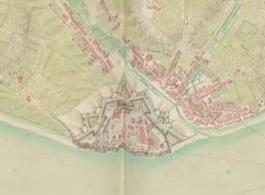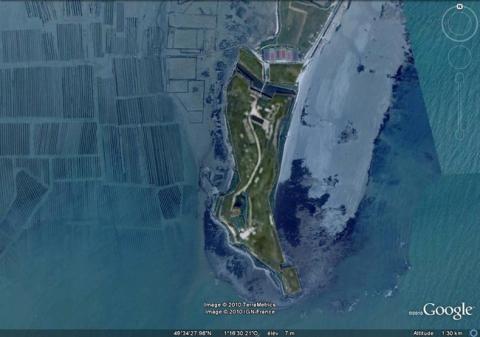Blaye citadel
History and description
A town of Roman origin, the first urban wall in Blaye was built in the middle Ages, as well as a castle. These fortifications were partially modified in 1652 by the Count of Pagan, who added some external work.In 1685, Vauban designed a defensive installation there, based on a triptych of fortresses which were intended to block access to Bordeaux: the first of which was the citadel, located on the right bank of the Gironde. To do so, he continued the modernisation which Pagan had commenced: the medieval urban wall was totally restored and transformed into a fortified urban wall. A caponier was also transformed into a gate, while a barbican became a bastion flank; the former medieval porte Saint-Romain became a military hospital. After these transformations, the construction of Vauban spawned an original fortification system: a high curtain wall surrounded the medieval wall and all the bastions were entrenched and separated from the interior by moats. The urban wall included three fronts equipped with two bastions and two demi-bastions, as well as two ravelins to defend the gates. The moats were dry. On the Gironde side, a terraced wall was built without any external features or bastions. Two large barracks, a governor’s residence, a powder keg and food stock houses were also constructed there. The construction site of the citadel, overseen by Ferry, was completed in 1692. The range of the cannons, however, proved too limited to prevent the passage of boats along the left bank of the Gironde, which was four kilometres wide at Blaye, hence two other fortifications were constructed from scratch: the fort Médoc and fort Pâté. Vauban designed the main basis of the project from 1685 and 1690. The engineer Ferry ensured the construction work underway was followed through.
Current state
Virtually all the fortifications of Blaye have been preserved. The citadel, abandoned by the army since 1950, is now used for accommodation and as a tourist venue. The tunnels have recently been opened to visitors and the site hosts numerous shows. The ramparts have been made into a city park.
Citadelle de Blaye
Citadelle de Blaye
45° 7' 43.8575" N, -0° 39' 56.4552" E
Type
citadel
Engineers
Claude de Saint- Simon, François Ferry, Sébastien le Prestre de Vauban
Department
Gironde
Region
Nouvelle-Aquitaine
Bibliography
- Dossier de presse, candidature au patrimoine mondial de l’humanité, Cussac-Fort-Médoc, 2005.
- COLAS (P.), Blaye, citadelle, boulevard du château, étude préalable, Bordeaux, 1991.
- COUTURA (J.), « Vauban à Blaye » in Les cahiers du Vitrezais, Paris, 1983, n°43.
- COUTURA (J.), « Quelques notes pour servir à l’histoire de la citadelle de Blaye, de Fort Pâté et Fort Médoc » in Les cahiers du Vitrezais, Paris, 1983, n°46.
- COUTURA (J.), « La construction du fort Pâté au milieu de la Gironde (1689-1693) » in Revue archéologique de Bordeaux, Bordeaux, 1991, t. LXXXII.
- FAUCHERRE (N.), « La citadelle de Blaye » in Congrès archéologique de France, Paris, 1990.
- MONGIN (M.), STEENBERGEN (M.), Le Verrou de l’Estuaire, Citadelle de Blaye, fort Pâté et fort Médoc, Woippy, 2014.

